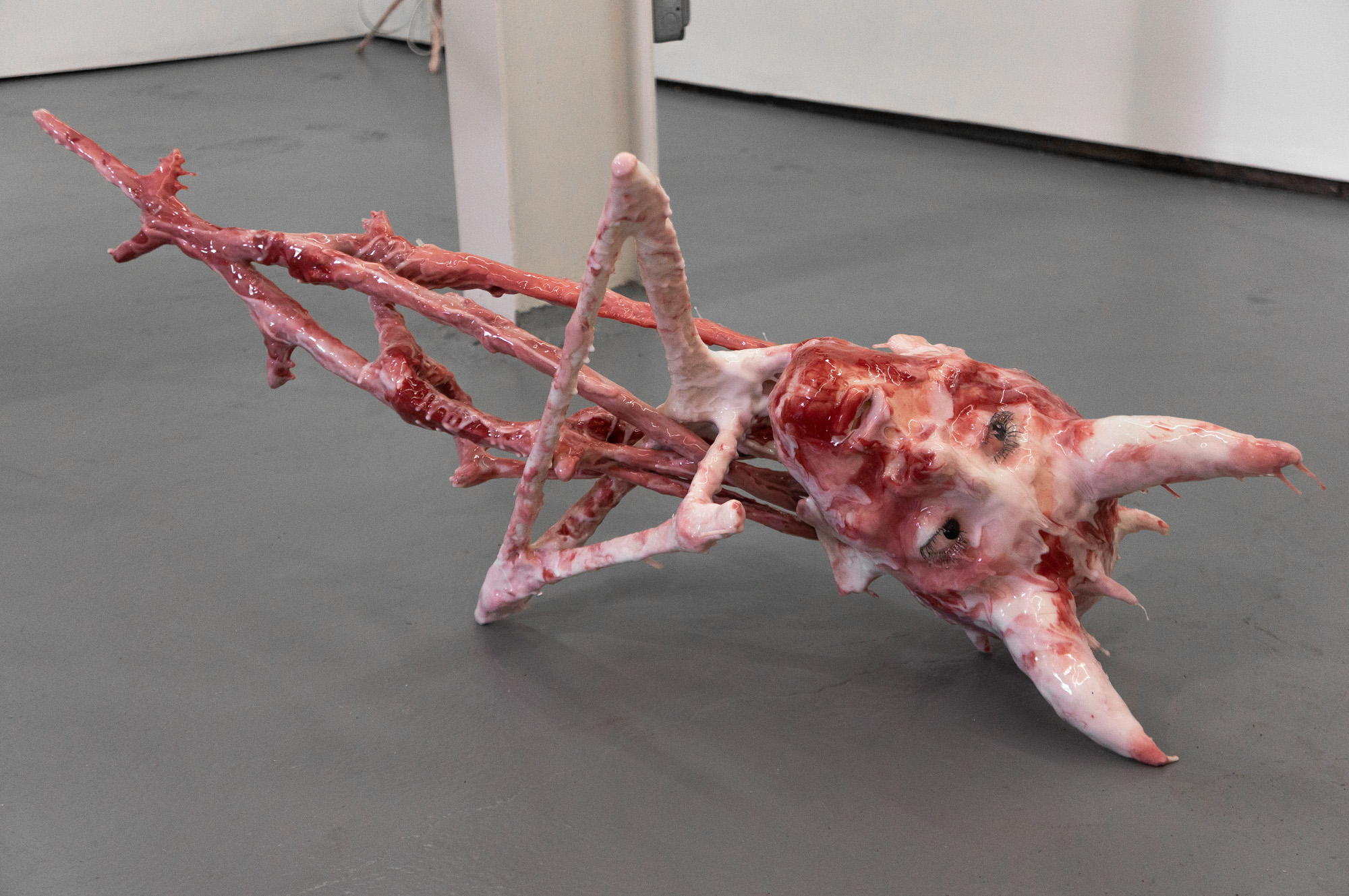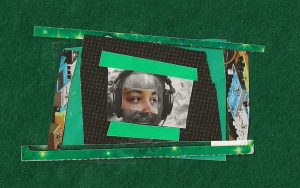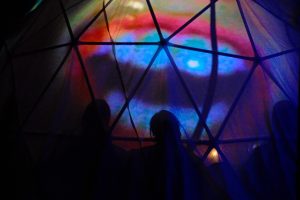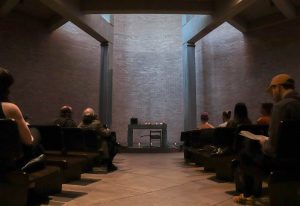Kristoffer Ala-Ketola explores queer affect through the fantastical and monstrous in his solo exhibition Dreams and Delusions at the artist-run gallery, 4th Ward Project Space (4WPS).
Located in Chicago around the corner of Nichols Park, 4WPS hides away at garden level in the grassy courtyard of residential apartments. The tucked away nature of the space creates a feeling of excitement for the viewer, as if they’ve discovered a secret, when walking down the steps to enter 4WPS.
Immediately noticeable against the stark white of the gallery walls is the color red in a variety of deeply-saturated hues in each artwork. Across the room are contorted sculptures made of pink flesh tones, red monochrome paintings, and a video of a man consumed by the color red. The red in Dreams and Delusions pulsates between red’s two intense psychological messages: repelled and attracted.
Many of the pieces in Dreams and Delusions generate a set of visceral sensations that Ala-Ketola describes coming from a deep fixation on “the dark milieu of uncertain forms of existence and the formation of identities.” Dreams and Delusions taps into a genre of bodily horror and transformation intertwined with the psychological accompanied by a bit of camp that provoke a duplexity of repulsed-yet-empathetic emotions.
At the center of the gallery is a dynamic figural sculpture titled, Geryon. The legs of this figure stand but are separated from the torso which lays on the ground at an angle with the head pointing downwards. One leg stands straight while the other(s) takes a contorted kneeling shape. The head, which has two horns, lays on the ground and the mouth and eyes remain open as if frozen in shock mid-collapse.
Geryon is directly inspired by a character named Geryon, sometimes “Geryoneis,” in ancient Greek mythology. He lived on the island Erytheia, which is an adjective meaning simply “The Red Place,” and was considered a monster. His features vary throughout history from having one body three heads, three bodies one head, six feet, wings etc. He was also known for his cattle, who were stained red by the light of the sunset. Geryon’s life comes to an end when Herakles feels extreme jealousy towards him. Eventually, Herakles kills Geryon and steals the cattle.
Geryon is also the main character in the poet Anne Carson’s famous novel in verse, Autobiography of Red, and this connection to the queer writer is by no means a coincidence. Carson’s book is a major inspiration for Ala-Ketola. Carson pulled the myth from the Greek poet Stesichoros (born c. 650 BC), and preserved fragments from the original text bearing the name Geryoneis. She then recasts the figure of Geryon in the 20th century, tracing life as a red, winged, and queer outsider from childhood onward. Unlike the myth, Carson’s tale does not end with Geryon’s death by Herkales hands, rather, Herakles takes the role as Geryon’s lover and the story ends when he breaks his heart.
Taking a closer look at the theme of queerness in Carson’s Geryon, it is evident that Geryon’s monstrosity serves as a direct link to issues of gender and sexuality. Geryon frequenlty confuses humans with animals and as the scholar Sebastien Ducasse points out, “Geryon is unable to make the difference between sexes.” and “he often stands in an in-between position alternating genders.” Like Geryon, the subjects in Ala-Ketola’s artworks have an indistinguishable identity.
Ala-Ketola frequently incorporates references, such as using symbolic imagery and red hues, to the ancient Greek myth and Carson’s book in the exhibition text, titles of the artwork, but Ala-Ketola recognizes Dreams and Delusions as a continuation of Geryon.
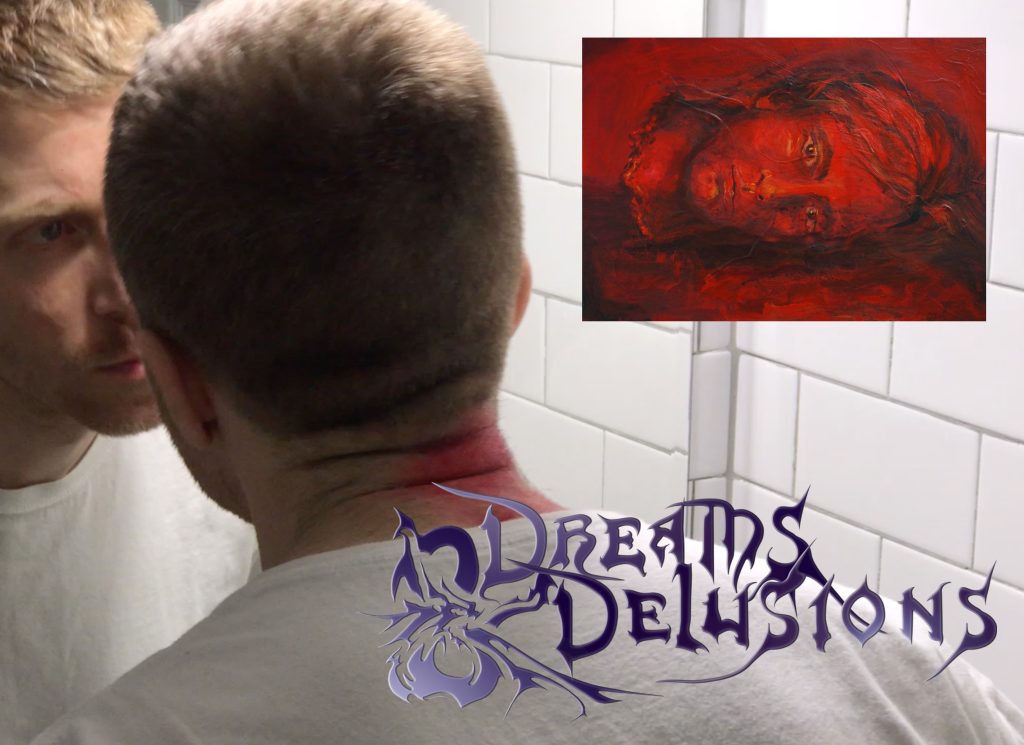
Ala-Ketola explains, “it was important for me not to try to illustrate the book or the myth, but rather create my own Geryon, on top of the previous one to keep it alive as this ever-changing phenomenon. So far he has appeared in ancient poems, Dante’s Inferno, Autobiography of Red, Dreams & Delusions, a tattoo I got from my artist friend Milena Huhta, and the countless hidden places the name has been mentioned.” Through Carson’s verses and Ala-Ketola’s aesthetic interpretation, Geryon is best understood as an identity that exists in a constant state of transformation—a position that refuses the belief that identity is fixed or determined by biology that can be empirically judged by strict standards based on morality and “truth.”
As the historian Susan Stryker once wrote about her own experience in an issue of GLQ, “When such beings as these tell me I war with nature, I find no more reason to mourn my opposition to them-or to the order they claim to represent than Frankenstein’s monster felt in its enmity to the human race. I do not fall from the grace of their company-I roar gleefully away from it like a Harley-straddling, dildo-packing leatherdyke from hell.” While Ala-Ketola’s works are not roaring gleefully away, they have a similar ambition to find a way to heal.
Ala-Ketola writes about his desire to depict monstrous characters in Dreams and Delusions:
“There has always been something alienating, alien, lonely, and misfit in the characters I create, but now I really wanted to highlight the fiction as a symbol. I wanted to also leave open how to read the monstrosity, but I guess for me it often signifies a trauma that the survivor had no control over. Finding empathy for the monstrous can be healing but also morally questionable, depending on how we define monstrous or which context we are talking about it from. For me the works are about healing– and more specifically, coping with something hurtful, violent, or otherwise difficult while getting better. I see healing as something that isn’t always a straightforward, positive and nice process.”
Ala-Ketola’s emphasis on a character like Geryon in Dreams and Delusions, invites us to think about how society has historically disrecarded queerness as something monstrous and “other” as well as how those bodies continue to go on despite their gnawing and aching trauma.
Mounted on the wall behind Geryon is the sculpture titled, Geryon’s Wings. They appear as a bone and stick wing structure with a hand at the center reaching towards the floor—or towards Geryon’s body(?)—with a small chain necklace balanced on the finger. The necklace has a small and delicate ornament, a wire shaped like a stick figure drawing of a human less than an inch tall and perhaps representing Geryon’s desire or the ideal of a complete form.
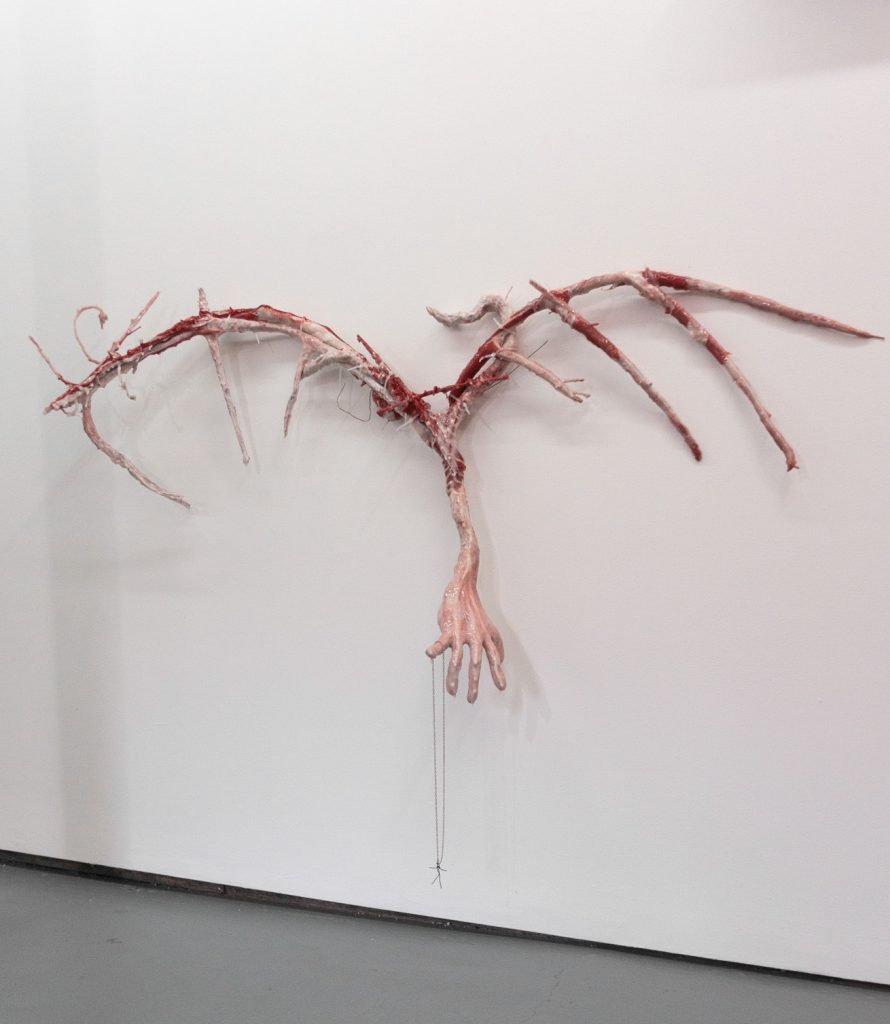
On the left of Geryon’s Wings is a video that features a person going about their daily routine; waking up, eating meals, traveling on the subway, returning home and going to bed. The color red appears on their skin behind their neck, then on their ankle, and eventually consumes their entire body like an infection.
To the right and slightly above Geryon’s Wings is a shelf with a portrait of a decapitated head on its side, titled Living, placed next to a small flesh sculpture, Splinter. The juxtaposition of Living and Splinter captures one aspect of Ala-Ketola’s humor that hides in many of the artworks. These pieces also balance the exhibition with its heavier themes such as horror.
On the right wall of the gallery there is a large wallpaper work with abstract shapes in pink and red hues that look similar to veins or synapses in the brain, titled Erytheia after the island Geryon lives with his cattle. This work functions as a sort of backdrop to Geryon at the center and another sculpture, next to Geryon, that sits on a pedestal titled Grasp that may be Geryon’s guard dog Orthrus from the original myth. It is a twisted figure constructed with various appendages. Grasp appears to be staring back at you with its dark eyes and dog-like face saying, “What am I?” or maybe “Where am I?” and “Where do I go from here?” This sculpture, as well as others, feel concurrently growing or melting and definitely alive.
Carson’s Geryon faces a similar crisis as Grasp. Throughout the Autobiography of Red, Geryon continues to ask, “what am I?”. He sets out to write an autobiography, making himself both the subject and the object of his writing, but before he can use language as a device Geryon constructs himself in a visual medium:
Geryon? fine he’s right here working on his autobiography
….
No it’s a sculpture he doesn’t know how to write yet
….
Oh this and that stuff he finds outside Geryon’s always finding things, aren’t you Geryon?
She winked at him over the telephone. He winked back using both eyes and returned to work.
He had ripped up some pieces of crispy paper he found in her purse to use for hair and was gluing these to the top of the tomato.
Ultimately, Geryon pursues the ontological quest of a self in search of himself using a variety of mediums, predominantly photography, and, as the scholar Sebastien Ducasse points out, is able to construct an autobiography without using “I.” In the end, however, Geryon finds that self-discovery is, in part, a journey towards seeing the self as one among other selves.
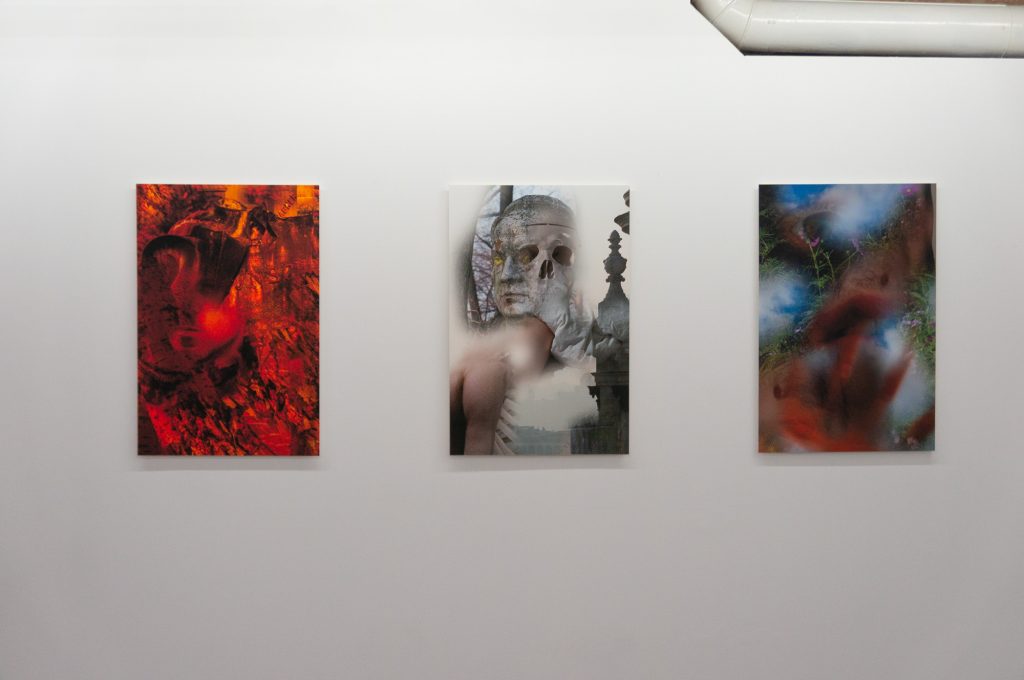
Many of the artworks in the exhibition are characters or identities who are in a continuous state of uncertain existence. Some of these characters or parts of characters are recognizable, such as Living, but others, such as the pigment prints Morphing, Dreaming, or Dissonance are more abstract and the mind wonders about what they are and where they come from. Through these pieces, Ala-Ketola contemplates identity and advances non-traditional methods of portraiture. He describes his thinking behind the portraits in Dreams and Delusions:
“A person engages in different modes of behavior depending on context, and presents themselves differently towards their mother as compared to a lover, or a coworker, while not being fully in control of their own performance, thus staying partly unknown even to themselves. This phenomenon of taking a role is influential to me, and I refer to these varying personas as ‘characters’. This problematizes the representation of such complex themes as identity or portraiture. I combine the psychological approach with my interest in language. A word can mean one thing in a sentence, yet expands its meaning when taken out of it and approached through semiotics. I navigate these ideas through engagement in self-portraiture and using my personal journal as a well for inspiration to let the personal experience morph into a shared affect.”
Ala-Ketola is especially interested in the visceral dissonances and difficulties that arise in identity. Many of the characters he creates are suggestively monstrous and have an undecipherable existence.
Ala-Ketola’s artworks navigate the affect of individuals, or metaphors of individuals like Geryon, who have been disregarded or rejected by society must live with their bodies and traumas. These bodies are queer in a sense that their queerness resides in identity but ultimately the abject perversions of difference—no matter how uncertain and undecipherable their affects may be. Encountering each artwork in Dreams and Delusions we are challenged to move beyond essentialist categories of identity and to think through the implications of difference. In order to truly engage with Dreams and Delusions, we must use our imagination, dream, and indulge in a delusion when an ambiguous sculptural form looks like its asking the question “what am I?” “where do I go from here?”
Kristoffer Ala-Ketola: Dreams & Delusions was on view at 4th Ward Project Space from April 24 through May 29, 2022.
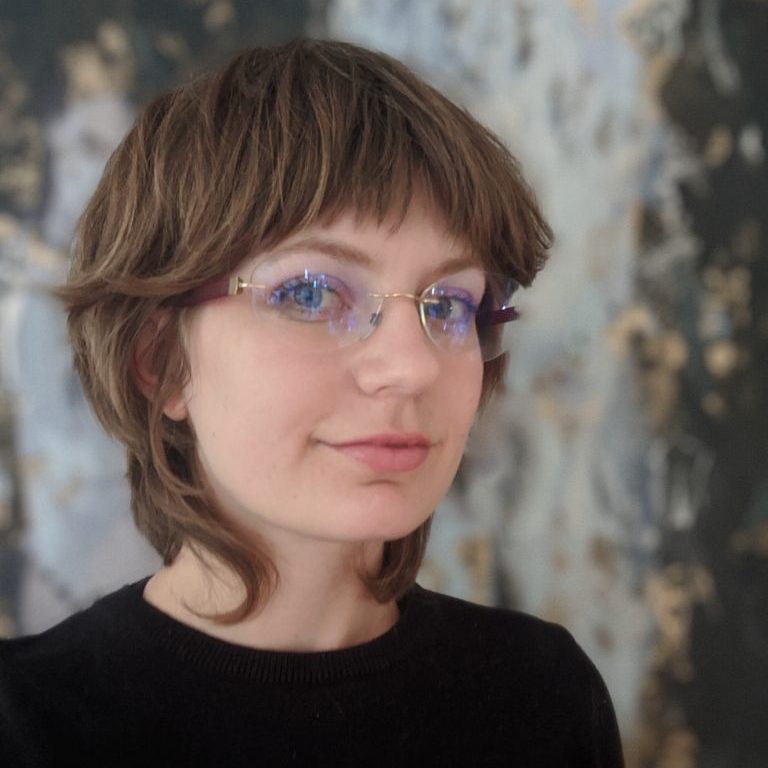
Livy Onalee Snyder is based in Chicago. She recently graduated from the University of Chicago with a Masters in Humanities. She has published in Denver Art Review: Inquiry and Analysis (DARIA), made contributions to Supernova Digital Animation Festival and interviewed artists for Black Cube Nomadic Museum. Currently, she holds a position at punctum books and advocates for Open Access. Read Livy’s writing for Sixty here.
